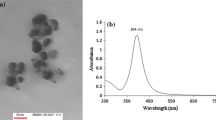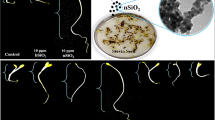Abstract
Nano priming is a new method for the increase of seedling vigor and improvement of germination percentage and seedling growth. The experiments to evaluate the effect of different concentrations of nano-anatase on germination parameters of parsley as a completely randomized design with five replications were performed in a tissue culture laboratory of the Department of Horticulture, Shahid Chamran University of Ahvaz. In addition, nano-anatase at four concentrations (10, 20, 30, and 40 mg/ml) was added to the Murashige and Skoog medium. At the end of the experiment, the percentage of germination, germination rate index, root and shoot length, fresh weight of seedlings, vigor index, and chlorophyll content were evaluated. The results showed that an increase in the concentration of nano-anatase caused a significant increase in the percentage of germination, germination rate index, root and shoot length, fresh weight, vigor index, and chlorophyll content of seedlings. The best concentration of nano-anatase was 30 mg/ml.



Similar content being viewed by others
References
Ely P, Heydecker W (1981) Fast germination of parsley seeds. Scientia Horticulturae 15:127–136
Rabin J, Berkowitz GA, Akers SW (1988) Field performance of osmotically primed parsley seed. Horticulture Science 23:554–555
Pill W, Kilian A (2000) Germination emergence of parsley in response to osmotic or matric seed priming and treatment with gibberellin. Horticulture Science 35:907–909
Podlaski S, Chrobak Z, Wyszkowska Z (2003) The effect of parsley seed hydration treatment and pelleting on seed vigour. Plant Soil Environ 49:114–118
Khayyam Nekoei S, Sharifnasab M, Ahmadisome H, Barkhivar K, Momeni M (2009) A review of Nanotech in Agricultural-Jehad ministry, 2nd edn. Publication of Agricultural Education 23:45–49
Ranjbar M, Shams G (2009) Applications of nanotechnology. Journal of Green Environment 34:85–87
Zheng L, Mingyu S, Xiao W, Chao L, Chunxiang Q, Liang C, Huang H, Xiaoqing L, Hong F (2007) Effect of nano anatase on spectral characteristics and distribution of LHCLL on the thylakoid membranes of spinach. Biol Trace Elem Res 120:273–280
Zheng L, Hong F, Lu S, Liu C (2005) Effect of nano-TiO2 on strength of naturally aged seeds and growth of spinach. Biology Trace Elemental Research 105:839–843
Feizi H, Razavi P, Shahtahmasebi N, Fotovat A (2011) Impact of bulk and nanosized titanium dioxide (TiO2) on wheat seed germination and seedling growth. Biol Trace Elem Res 146:101–106
Hosseini HR, Chehrazi M, Nabati Ahmadi D, Mahmoodi Sorestani M (2013) Study the effects of colchicine treatment on generation of autopolyploidy in Catharanthus roseus cvs. Rosea and Alba. M.Sc. Thesis. Shahid Chamran University of Ahvaz. Iran.
Hashemi Dehkourdi E, Mosavi M, Moallemi N, Ghafarian Moghareb MH (2013) Effect of nanoparticles of anatase (TiO2) on some of characteristics quantity and quality of fruit of strawberry in hydroponic condition. M.Sc. Thesis. Shahid Chamran University of Ahvaz, Iran.
Savithramma N, Ankanna S, Bhumi G (2012) Effect of nanoparticles on seed germination and seedling growth of Boswellia ovalifoliolata an endemic and endangered medicinal tree taxon. Nano Vision 2:61–68
Gao F, Hong F, Liu C, Zheng L, Su M, Wu X, Yang F, Wu C, Yang P (2006) Mechanism of nano-anatase TiO2 on promoting photosynthetic carbon reaction of spinach. Biol Trace Elem Res 111:239–253
Ruffini Castiglione M, Cremonini R (2009) Nanoparticles and higher plants. Caryologia 62:161–165
Owolade OF, Ogunleti DO, Adenekan MO (2008) Titanium dioxide affected diseases, development and yield of edible cowpea. Electronic J Environ Agric Food Chem 7(5):2942–2947
Farahani HA, Sani B, Maroufi K (2012) The germination variations in fleawort (Plantago psyllium L.) by nano-particle. International conference on biotechnology, nanotechnology and its application 12: 43–46.
Lei Z, Mingyu S, Xiao W, Chao L, Chunxiang Q, Liang C, Hao H, Xiao-qing L, Fashui H (2008) Antioxidant stress is promoted by nano-anatase in spinach chloroplasts under UV-B radiation. Biol Trace Elem Res 121:69–79
Author information
Authors and Affiliations
Corresponding author
Rights and permissions
About this article
Cite this article
Dehkourdi, E.H., Mosavi, M. Effect of Anatase Nanoparticles (TiO2) on Parsley Seed Germination (Petroselinum crispum) In Vitro. Biol Trace Elem Res 155, 283–286 (2013). https://doi.org/10.1007/s12011-013-9788-3
Received:
Accepted:
Published:
Issue Date:
DOI: https://doi.org/10.1007/s12011-013-9788-3




